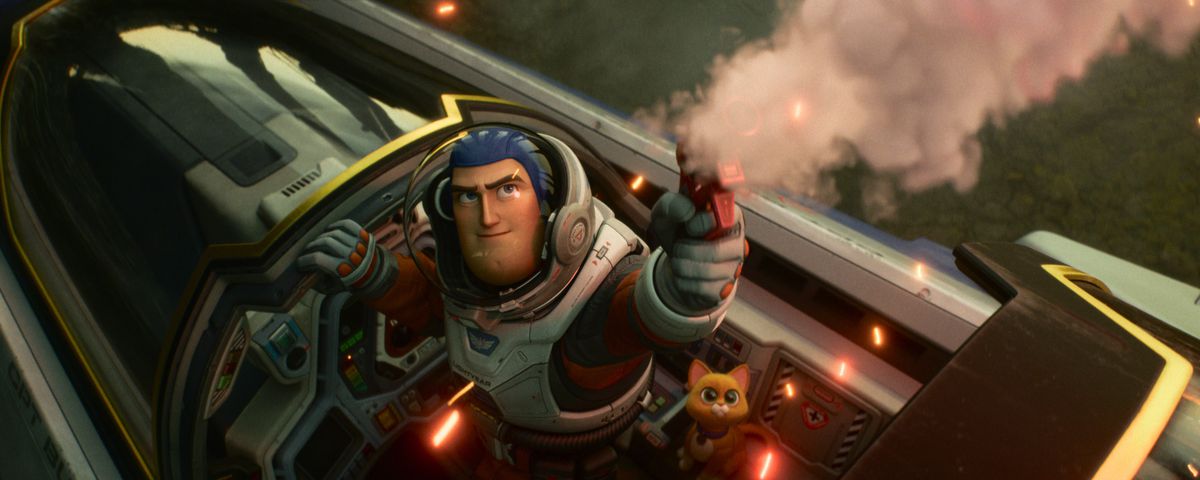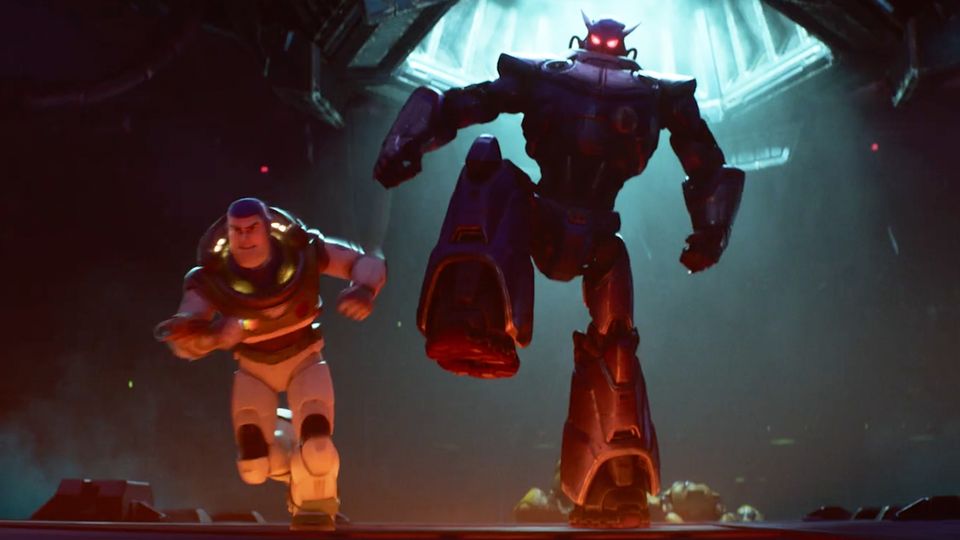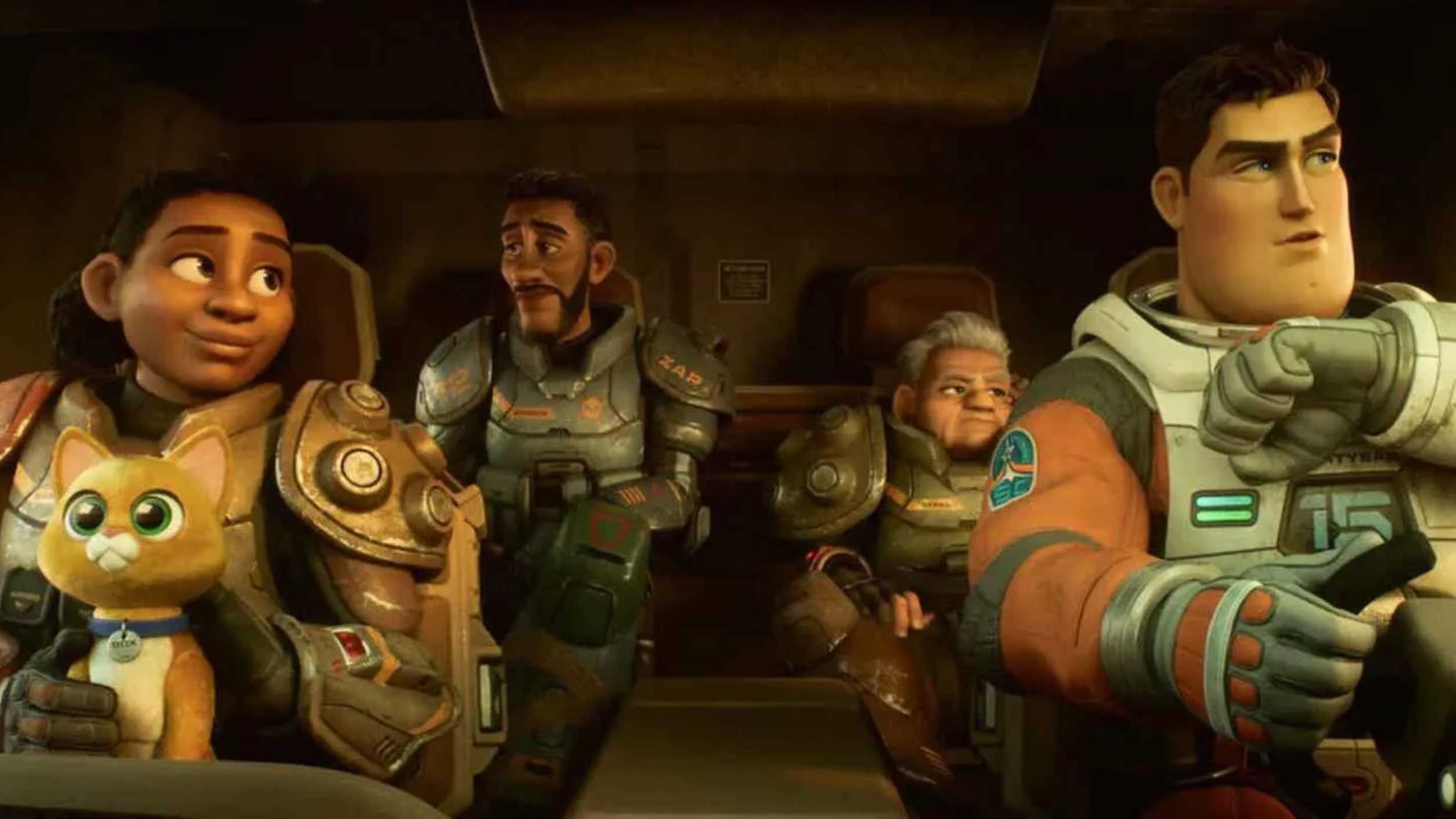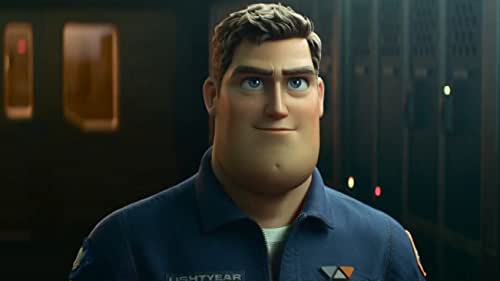In 1995, Buzz Lightyear was introduced to two worlds: the children within Toy Story, who wanted a Buzz Lightyear action figure because they’d seen him in an awesome movie, and the real people in our world, marvelling at the magnificence of Pixar’s first feature. Now, Pixar has gotten too clever by half in trying to squeeze a little bit more out of its bankable IP, giving us a glimpse of the movie that made kids aspire to be Buzz and add him to their toy chests – ideally, a feature-length version of what the video game opening of Toy Story 2 set out to do, which is to depict Buzz in his “real” environment.
It’s hard to imagine that Lightyear, the supposed 1995 movie, would trigger the sort of obsessiveness that made kids older and younger than them want Star Wars figures or Harry Potter toys. That’s because it doesn’t resemble a movie made in 1995, so stuffed is it with 2022 ideas.
It’s not just that there’s a prominent lesbian relationship in the movie – kudos to Pixar on that, and that’s the sort of anachronism we embrace in the quest for an ever more inclusive 2022. No, it’s that this Buzz is a hero who fails repeatedly and stupendously, and not in the funny ways you might expect if he were a dim-witted hero in the mould of Inspector Gadget, who stumbles his way to good outcomes – a viable way to go with this material. He fails in ways deep and existential and sad. No kid who saw this movie in 1995 would race out of the cinema with their arms thrust forward, Superman-style, shouting “To infinity and beyond!”
Lovely as they are, children are not capable of much nuance. Even today but particularly in 1995, they don’t look at heroes as a volatile mixture of strengths and weaknesses resulting in a net positive, a level of complexity that maybe some of today’s Marvel and DC heroes approach. No, for them to want a Buzz Lightyear toy, he’d have needed to be far more uncomplicated and unproblematic than the way we look askance at our heroes in 2022, far more like the broad-chested, lunk-headed speaker of hokey space jargon we first met when Tim Allen voiced him in 1995.
It’s Chris Evans, the erstwhile Captain America, who gives voice to Buzz in 2022. That’s not a bad choice, but Evans lacks Allen’s instinct for self-deprecating humour, and the depiction of Buzz greatly suffers for it. Then again, this isn’t a dumb Buzz, it’s an ornery Buzz – stubborn in ways that are actually damaging to those around him, irritable in ways that turn viewers off. My kingdom for the oblivious Buzz we once knew. There was no reason he had to be excluded from this movie, even if they wanted to exclude Allen.
Lightyear tackles concepts that writers of space adventures scarcely dreamed of in 1995. Buzz and his fellow space ranger Alisha (Uzo Aduba) are accompanying a large vessel in search of a habitable planet for its contingent of deep-sleeping inhabitants. However, when the planet attacks them in all sorts of ways – viny tentacles emerging from the earth, overgrown flies descending from the skies – they decide to move on to the next habitable planet. Except that Buzz takes too risky of an angle of ascent in lifting off, scraping the side of a cliff and damaging the ship and its hyperspace components beyond repair, leaving them marooned.
With the help of the scientific crew using the planet’s natural resources, Buzz gets a test version of the hyperspace drive, and must use a smaller ship to catapult around a local star to see if it might be safe for transporting these people back home. Not only is the compound not stable, but the test results in a loss of time for Buzz – somewhere around four years, to be exact, though it feels like only minutes to him. It’s one of those Interstellar-style mind-blowers about how time passes differently for different people in space, and let’s just say it’s only the first such test.
The most generous way to describe the chosen plotline of Lightyear is that it feels like a seventh movie in a hypothetical Buzz Lightyear series, when all the ordinary adventures involving ordinary space ranger duties and good fights against the Evil Emperor Zurg have been exhausted, and the screenwriters are pushing themselves outside the box. A reveal about Zurg, who does appear here as the villain, also befits an umpteenth sequel.
There’s a total disjuncture, though, between the heroic score that accompanied the TV ads for the toy in Toy Story, and the movie Pixar’s team has now tried to link up to those ads. It looks cool and it has some good gadgets, but as a narrative, it’s a total bummer. Some of the ways it’s a bummer are spoilers, but generally speaking, Pixar wants us to contemplate the fleeting nature of time and our blindness to the good things we have in life as we stubbornly try to complete our mission – the completion of his mission being a thing on which Buzz fixates. That’s suited for any number of other Pixar movies, but it’s a risky gambit in this one, and it doesn’t pay off.
The other thing we know about Buzz from 1995, besides his sweet machismo, is that he really needs a Woody to play off of. The characters joining Buzz on this journey are disappointingly conceived. The co-lead is a ranger in training named Izzy (Keke Palmer), who is likeable, but doesn’t function as an effective personality contrast to Buzz, like Woody did. She’s flanked by two other rangers in training who surely looked better on the page than they came out here – Darby (Dale Soules), an elderly parolee who is even more ornery than Buzz, and Mo, a naïve recruit who should have become a crowd favourite just because Taika Waititi does the voice work. Sadly, that’s not the case.
The most enjoyable character is probably the AI cat, Sox, voiced by Pixar director Peter Sohn, who certainly has his moments in the “funny computer” role. Even his effectiveness is muted a bit, though, by the decision to spread the “funny computer” role to a second (if smaller) character, a navigation system named I.V.A.N.
Pixar recognises the need to make Lightyear fun, but it’s an uphill battle. There’s not much buzz in this Buzz. Even if you aren’t stubbornly fixated, Buzz-style, on the dubious central conceit that we are looking at a movie made in 1995, there’s little about this that provides the sort of gee-whiz, carefree, pastel-coloured enjoyment we’re seeking from a Buzz Lightyear movie. Irony certainly existed in 1995; even that version of Buzz Lightyear is poking holes in our traditional notion of a hero. But it poked those holes while also loving him and his foibles. Maybe that’s been lost along the way.
Lightyear is currently playing in cinemas.




